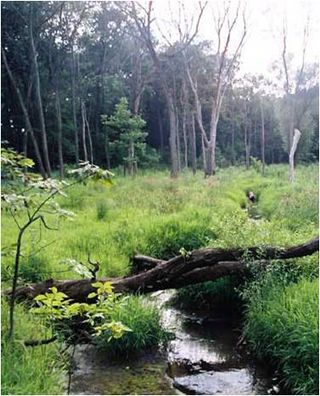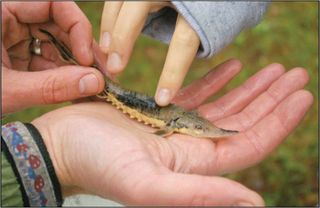Bridging the Gap Between Scientists and the Public

This Behind the Scenes article was provided to LiveScience in partnership with the National Science Foundation.
In recent years, more scientists have begun to realize that it's not enough to just do science. Researchers have to be able to explain their work in words that make the discoveries relevant and understandable to decision-makers and the public.
"I've learned that the people side of things is just as important as the technical side," said Alex Mayer, of Michigan Technological University, who studies water resources. Specifically, Mayer focuses on ways to ensure safe and affordable water supplies. "We need to be able to explain quite well to the rest of the world how it is we do our work. When you think about it, our goal as scientists really is to achieve a consensus of rational opinions about a particular issue. Another part of our job is to convey to the world how we reach that rational consensus."
To this end, he is using several approaches to help train doctoral students in a National Science Foundation sponsored "GK12" program on how to communicate water issues, including the importance of working with members of the media as well as with those who have a stake in the outcome, such as legislators, local officials and other policymakers.
"I've learned, working on water issues, that you have to go beyond proposing engineering solutions that you think can solve the problems," Mayer said. "You also have to understand the politics, and the needs of the people you are working with. I've worked with sociologists, anthropologists and economists to look at all sides of the issue."
Students teaching students
Additionally, the program brings Ph.D. students into middle school classrooms to teach students about watershed science. In the classroom, the grad students hone their communication skills, and help cultivate the next generation of scientists. However, the most important objective is to "increase each Ph.D. student's ability to communicate the content of their research, and how they go about doing it," Mayer said. "Putting them into middle-school classrooms, and having them develop lesson plans and activities that convey their work, turns their esoteric science into material that is appealing and engaging — and also turns [the students] into better communicators."
Sign up for the Live Science daily newsletter now
Get the world’s most fascinating discoveries delivered straight to your inbox.
Meagan Harless, a Ph.D. student participating in the science communication program at Michigan Tech, discovered during her first day in class, how little the youngsters knew about the kinds of things scientists study, and how they go about doing it.
"They pictured a scientist as an often-depicted 'mad scientist' lurking about in a dark laboratory with big glasses, out of control hair, a white lab coat, goggles andsurrounded by test tubes oozing various colored liquids," Harless said. "They were surprised to learn that scientists are involved in many disciplines and how these scientists are working to improve the lives of all people. In particular, they were surprised to learn about ecological and environmental scientific disciplines.... Science is all about curiosity, developing questions about what we observe and designing experiments to answer those questions. I think students are naturally very curious, and they appreciate the opportunity to use their innate curiosity in class."
Hands-on science

With that in mind, Harless introduced an activity to her eighth-graders that enabled them to better understand her research focus — conservation and management of water resources — and allowed them to develop questions and design experiments to find the answers.
The activity involved a fictional groundwater contamination scenario in a small town. "The students were taught about what groundwater is and how different pollution sources may affect its quality," she said. The students were given background information on a pesticide spill in a small town, and a map of the town. They worked in small groups to develop a hypothesis as to where the pesticide spill originated.
"We used groundwater samples taken from wells throughout the town to model the plume of the pesticide contamination in the groundwater," Harless said. "Students acted as hydrologists and were excited to be in control of where and how they sampled their water."
Ultimately, the students wrote a report of their findings, including the hypothesized origin of the pesticide spill. "I think this lesson was particularly effective as it was very applied in nature, and the students were able to use their science research to benefit members of the community," she said.
Communicating climate
Along with their classroom experience, the doctoral students also became involved in a communications project that focused on climate change. They read materials on the subject, participated in discussions, and drafted a press release about climate change research at their university.
They also learned how journalists operate because, "these are the people who should become your allies in getting the word out," Mayer said. "We chose climate change because it's just so rich with communications issues."
"It's a great example. It's controversial, and you have people who squawk about it all the time — so it's important to be able to communicate clearly about climate science," Mayer said. "Our students' research may never be as controversial and political as climate change, but the students now have learned that when they go on to their own science careers, they have to speak out about what they do know, and what the science is."
Harless has come to understand this very well through the program. "I think there is a big misunderstanding between the public perception of how the discipline of science works and how conclusions drawn from scientific research may be interpreted," she said. "It's up to the scientists to close this gap with knowledge. When scientists provide this information, and stress how important science is in society, they will gain public support for their research."
Editor's Note: This research was supported by the National Science Foundation (NSF), the federal agency charged with funding basic research and education across all fields of science and engineering. Any opinions, findings, and conclusions or recommendations expressed in this material are those of the author and do not necessarily reflect the views of the National Science Foundation. See the Behind the Scenes Archive.
Most Popular


